Ciabatta Bread
This post may contain affiliate links. Read the full disclosure here.
This simple Ciabatta Bread recipe will give you a rustic Italian loaf that is perfect for dipping into soups or sauces. The high hydration in this bread results in a wonderfully chewy center and tons of irregular holes.
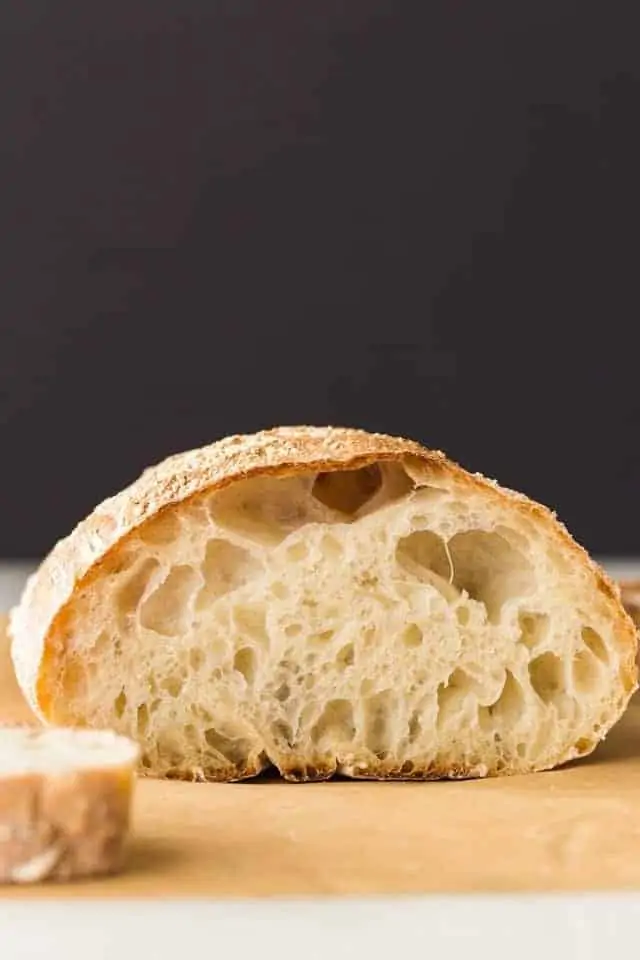
Homemade ciabatta bread
This is probably the easiest ciabatta bread recipe you’ll come across. It is an 80% hydration bread which means it’s very wet and sticky.
Because of this, you’ll need a stand mixer to make the dough. Otherwise, it will be near impossible to mix the dough.
The mixer will do all the mixing and kneading for you. This is why I say it’s the easiest recipe.
No-knead recipes are the best! I make focaccia, baguettes, pizza dough, and slow cooker bread all the time because they require little effort. And now I’ll be making ciabatta bread just as often, if not more.
Ciabatta means slipper in Italian. Can you see how the bread gets its name? It’s shaped just like a slipper!
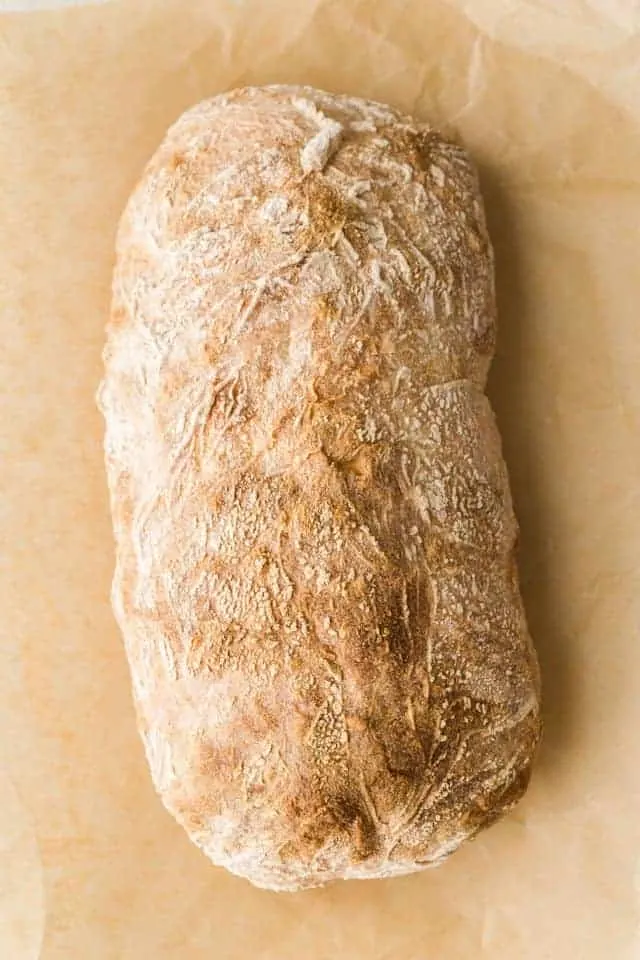
Are there eggs in ciabatta bread?
There are no eggs in ciabatta bread. It’s made with flour, water, yeast, and salt.
What do you use ciabatta bread for?
You slice ciabatta bread at an angle and drizzle it with olive oil. It can also be used for dipping in soup or soaking up a sauce.
Or you can slice it lengthwise and make an Italian Style sandwich. Whichever way you decide to enjoy this bread, I’m sure you’ll be impressed with the texture and flavor.
How do you heat up ciabatta bread?
You can heat ciabatta bread by wrapping it in aluminum foil and baking in a 350°F oven for 10-15 minutes.
Main ingredients for ciabatta bread
Bread flour – this is essential for the sturdy texture of this bread.
Yeast – you can use instant or active dry yeast. Either one will work. Just be sure to use a quality brand like Red Star®.
Water – there’s a lot of water in this bread and it’s the only liquid the recipe calls for.
Salt – salt boosts the flavor of ciabatta bread but also slows down the fermentation and enzyme activity in the dough. It helps to strengthen and support volume as well.
How to make ciabatta bread?
Step 1: Make the sponge
Combine flour, yeast, and water in a large bowl. Stir it with a wooden spoon until it’s well mixed and free of lumps.
Cover the bowl with plastic wrap and let sit at room temperature for at least 15 hours but up to 20 hours. The longer you let the sponge sit, the more flavor and structure the final bread will have.
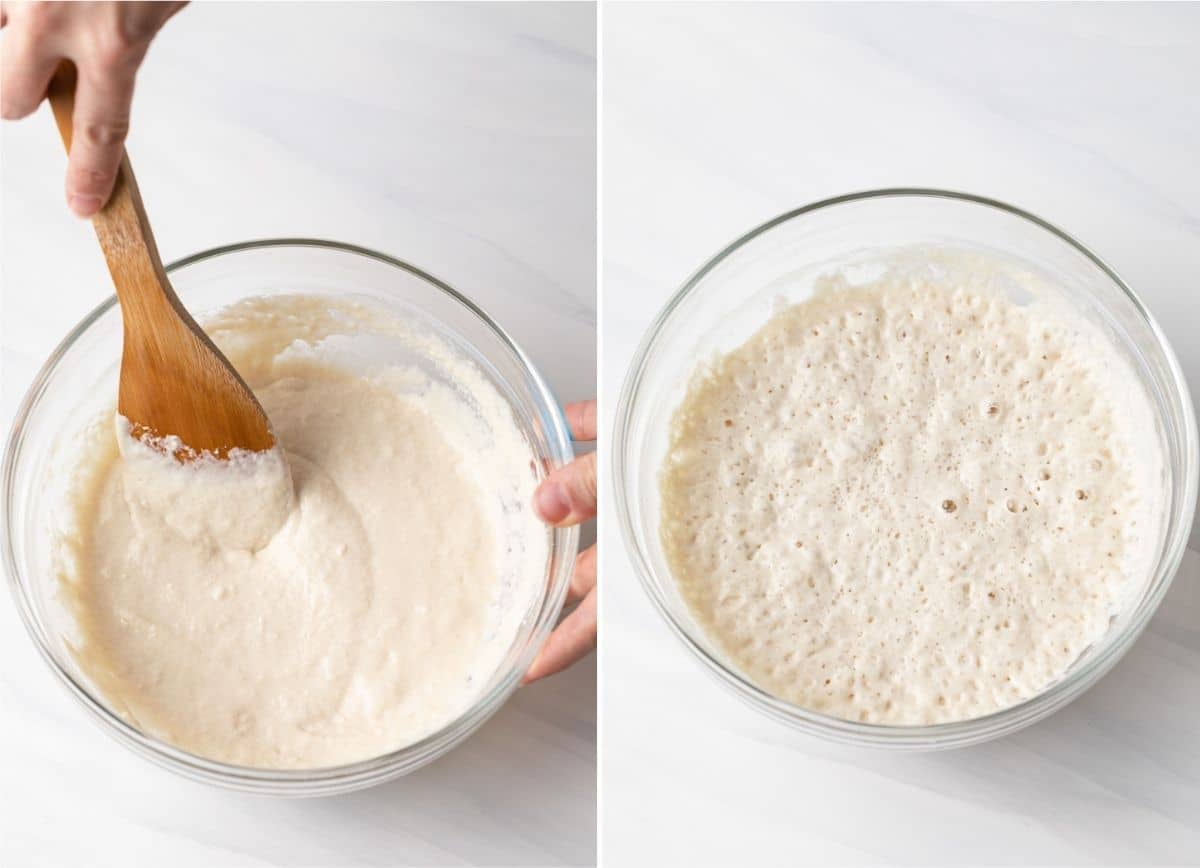
Step 2: Make the dough
In the bowl of a stand mixer, combine the sponge with more flour, water, salt, and yeast. Mix it with the dough hook until the dough no longer sticks to the sides of the bowl.
The dough will be very soft and batter-like. This is normal for ciabatta.
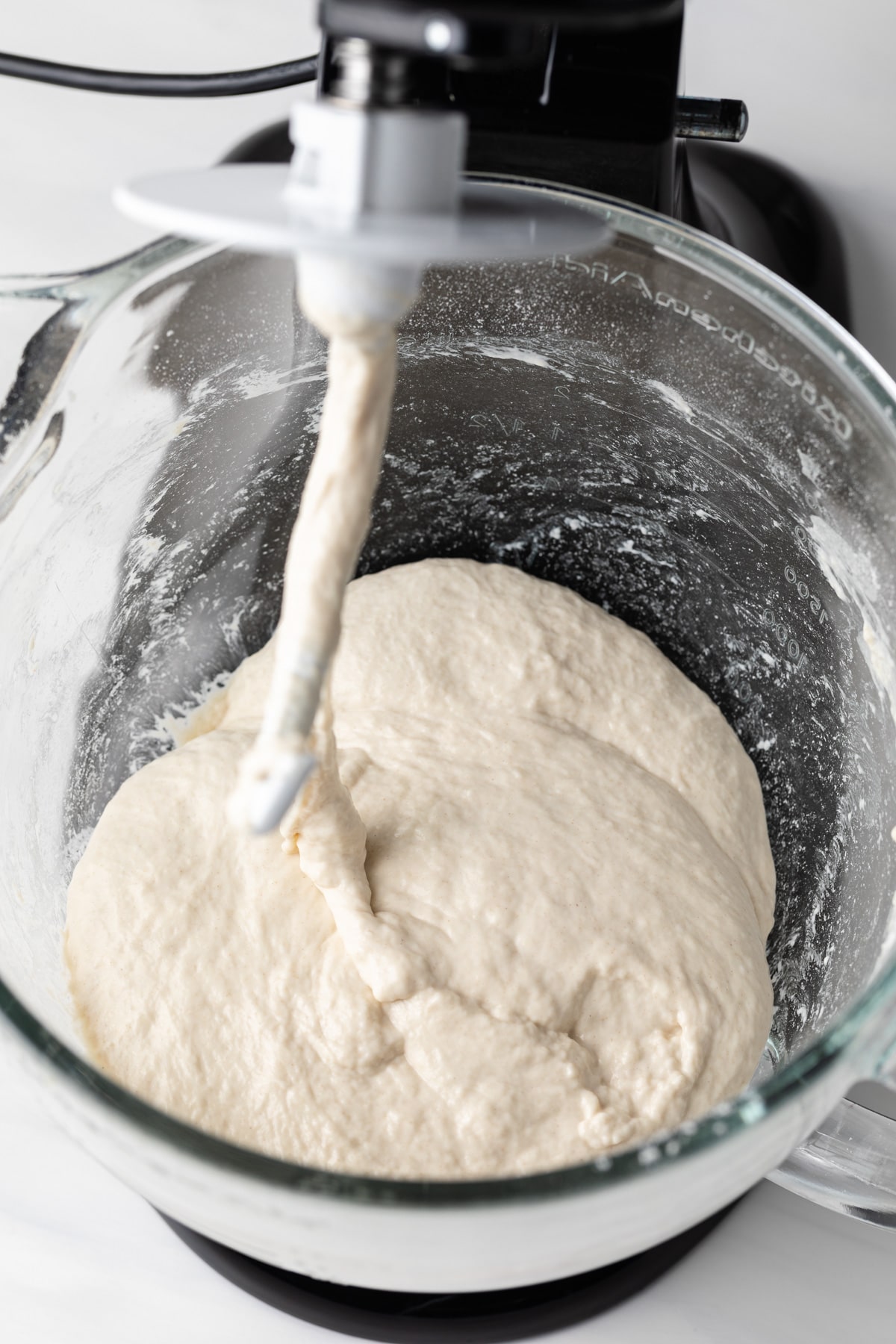
Step 3: Rise and turn the dough
Transfer the dough to a large bowl greased with olive oil. Cover and let it rise for 1 hour. Use wet hands or a greased silicone dough scraper to gently lift and fold the dough over onto itself. Flip the dough over so the top is now the bottom.
Cover the bowl and let the dough rise for 45 minutes. Repeat the folding process twice more and let rest for another 45 minutes after each.
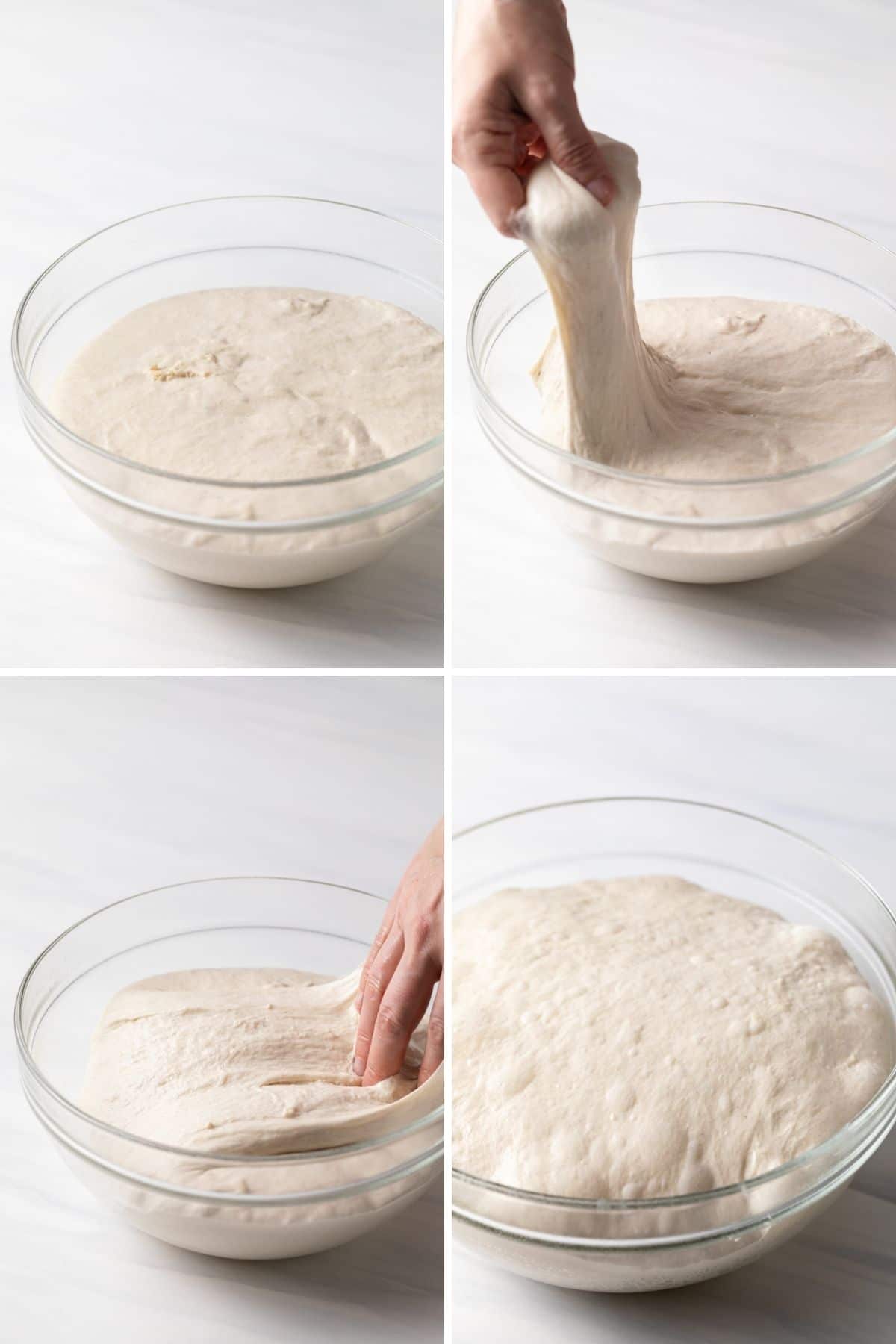
Step 4: Shape the dough
Transfer the dough to a well-floured surface and liberally flour the top of the dough. Use two well-floured bench scrapers and carefully manipulate the dough from the sides to form a square.
Don’t add any pressure to the top of the dough or it will deflate. Cut the square in half and use the bench scrapers to gently shape each half into a loaf.
Gently slide the bench scrapers under the dough and transfer each loaf to an inverted baking sheet lined with parchment paper. Cover the loaves with a cloth and let rise at room temperature for 30 minutes.
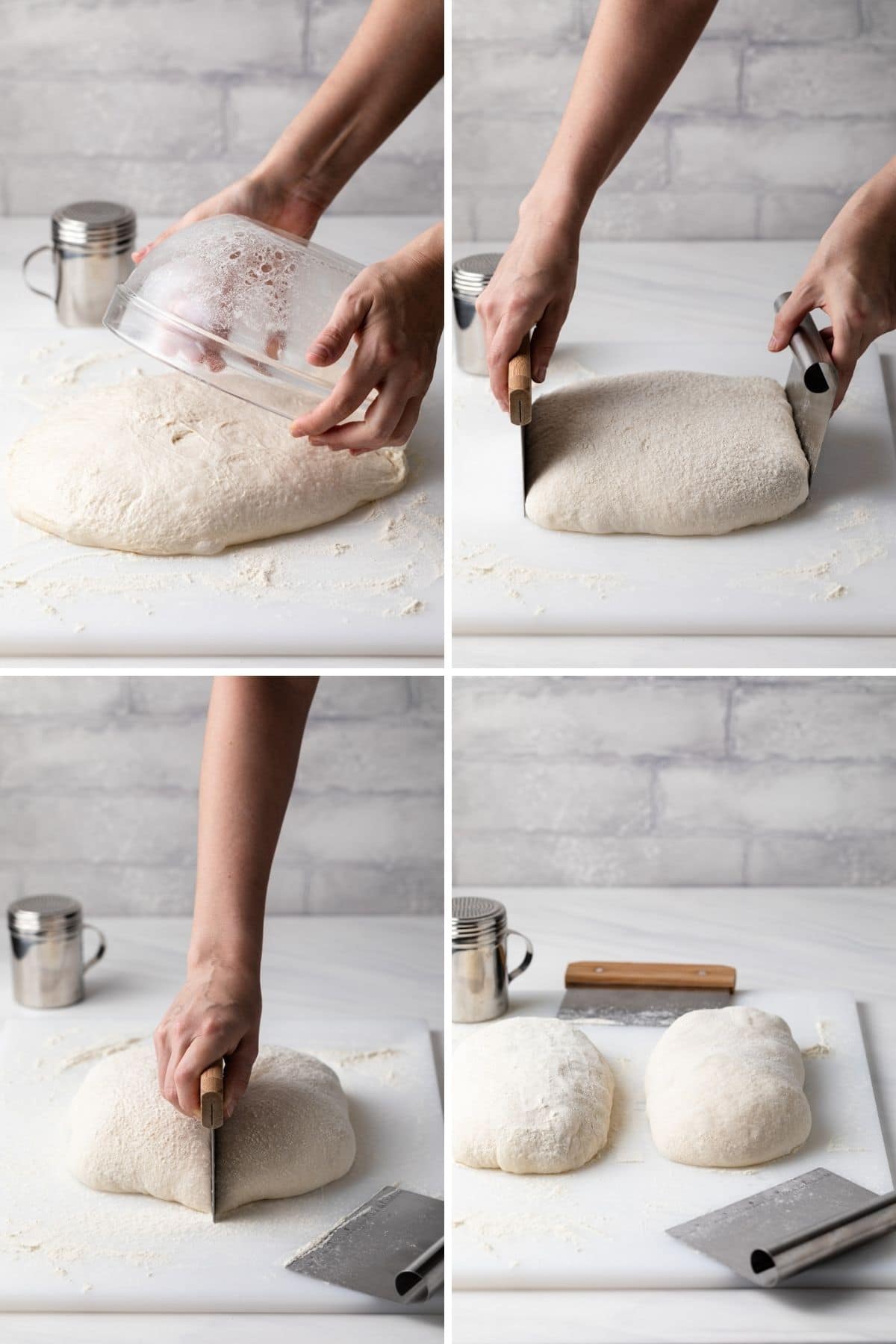
Step 5: Bake
Invert a baking sheet onto the rack just below the center of the oven and heat to 450°F.
Spray the loaves lightly with water. Then, carefully slide the parchment with the loaves onto the heated baking sheet in the oven. Bake for 25-30 minutes.
It’s important to bake with steam to create a crisp, golden crust. Do this by placing a cast iron on the lowest rack. When transferring the loaves to the oven, add 1 cup of ice to the cast iron. The ice will melt and steam during the first few minutes of baking.
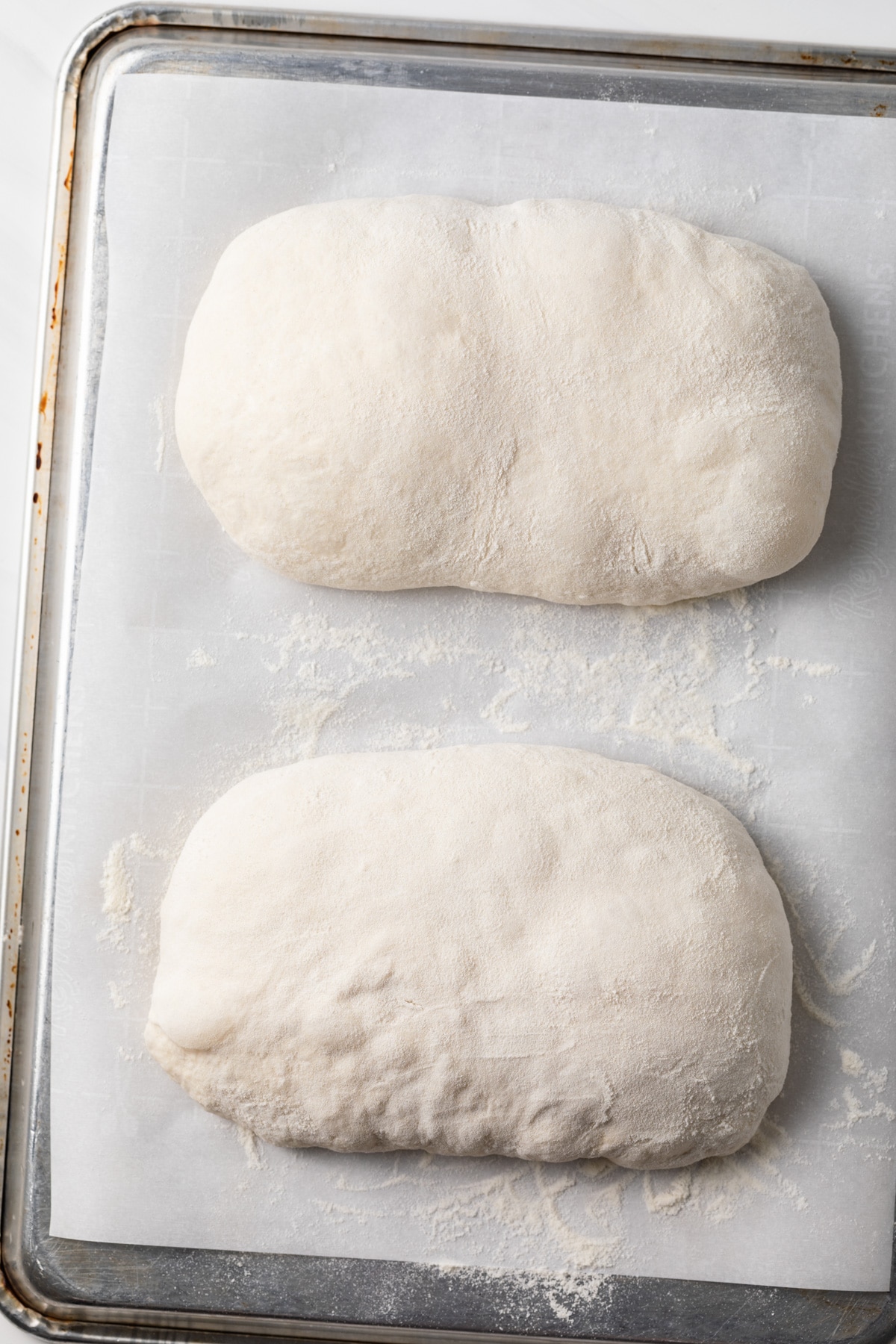
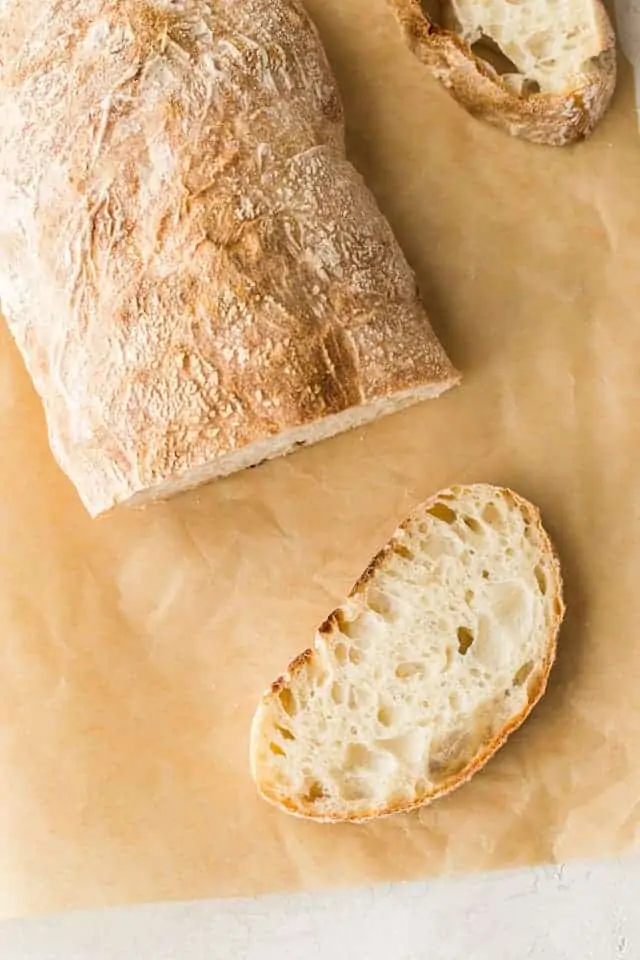
I don’t have a mixer. Can I use a food processor? Or can I mix by hand?
A stand mixer is recommended for this recipe! This dough is high in hydration, meaning it is very sticky. A stand mixer is the easiest way to mix it.
You can try mixing it with a wooden spoon and kneading it by hand but be mindful that adding more flour during kneading will affect how the bread turns out.
I don’t recommend using a food processor for mixing.
Tips for this easy ciabatta bread recipe
- Plan ahead since the sponge needs to be made a day in advance.
- The dough for this bread is very wet and sticky. It requires a lot of external flour to prevent it from sticking. If you use too much flour on the outside, you can easily brush it off before spritzing the loaf with water and baking. Just use a pastry brush* to do this.
- The dough will puff up and resemble a giant marshmallow. Be very delicate when shaping it so you don’t knock out all the air. The air is what gives the bread those gorgeous irregular holes.
More yeast bread recipes you’ll love
Some quick bread recipes you might like
- Irish Soda Bread with Raisins and Caraway Seeds
- Best Ever Banana Bread
- Cheddar Jalapeno Buttermilk Bread
Homemade Ciabatta Bread
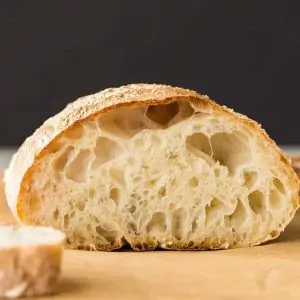
Ingredients
For the poolish
- 1 ½ cups (200 g) bread flour
- 1 scant cup (200 ml) water, room temperature
- ¼ teaspoon instant yeast
For the dough
- 2 ⅔ cups (350 g) bread flour
- 1 cup (240 ml) water, room temperature
- 2 teaspoons salt
- ½ teaspoon instant yeast
Instructions
Make the poolish
- Combine the flour, water, and yeast in a medium bowl. Stir with a wooden spoon until fully combined and the mixture is smooth. Cover with plastic wrap and allow it to ferment at room temperature for 15 to 20 hours.
Make the dough
- Add the poolish and all ingredients for the dough to the bowl of a stand mixer fitted with the paddle attachment. Mix on low speed until all the flour is moistened, about 2 minutes. Increase the speed to medium-low and mix until dough forms into a mass and pulls away from the sides of the bowl, about 6 minutes.
- Switch to the dough hook attachment and mix on medium-low until dough becomes smooth and shiny, about 10 minutes. The dough will be soft, wet, and sticky much like batter.
- Lightly coat the inside of a large bowl with olive oil or nonstick spray. Use a silicone dough scraper to scrape the dough into the bowl. Cover with plastic wrap and let rise for 1 hour at room temperature.
- Using a greased scraper or damp fingertips, gently grab one side of the dough, lift and stretch it over the top of itself. Turn the bowl 180 degrees and stretch the same way. Rotate 90 degrees, stretch and fold. Rotate 180 degrees to stretch and fold the final side. Flip the dough over so the bottom becomes the top. Cover with plastic wrap and let rest at room temperature for 45 minutes. Repeat folding two more times, then cover with plastic wrap and let sit for an additional 45 minutes after each.
- Adjust the oven racks so that one is in the lower-third position (just below the center) and one is at the very bottom position. Place a cast-iron skillet on the lowest rack and an inverted baking sheet on the upper rack. Heat the oven to 450°F. It’s important to let the oven preheat for at least an hour to ensure it is hot enough.
- Liberally dust your work surface with flour and let the dough slide out of the bowl onto the counter. Be very gentle here so you don’t knock all the air out of the dough and try to handle the dough as little as possible. Liberally dust the top of the dough with flour. Using 2 well-floured bench scrapers, carefully manipulate the dough from the sides to form a square. Take care not to put pressure on top of the dough.
- Cut the dough in half, down the middle of the square. Gently shape each half into loaves by using the bench scrapers to manipulate the sides.
- Invert a large baking sheet and place a sheet of parchment paper across the top. Dust liberally with flour. Using both bench scrapers, slide them under both ends of the dough and transfer the dough to the prepared parchment paper. Repeat with the remaining loaf. Use your fingertips to gently poke the surface of each loaf as you shape it into a rectangle.
- Cover with a lint-free cloth to prevent the loaves from drying out. Proof in a draft-free place until puffy and the surface develops small bubbles, about 30 minutes.
- Have 1 cup of ice ready. Mist the loaves with water and carefully slide the parchment with loaves on the heated baking sheet in the oven using a jerking motion. Immediately drop the ice into the cast-iron pan on the bottom rack. Quickly close the oven door.
- Bake, until the crust is a deep golden brown, about 25-35 minutes. The internal temperature of the bread should be 210-215°F.
- Transfer to a rack to cool completely before slicing and serving
Notes
- It’s very important to measure the ingredients correctly! While I do list cup measurements, if you do not measure accurately, the dough will not form properly. For 100% success with this recipe, please use the weight measurements. This is a soft, sticky dough. It’s difficult to work with and requires patience.
- This is a 80% hydration bread. If you have difficulty working with the dough, lower the hydration to 70% by using 3 ¼ cups (422 g) flour in the dough.
- You may bake the bread on an oven stone if you prefer. Place it in the oven to preheat in step 5.
- Shaping ciabatta: This is meant to be an easy recipe with limited handling. Because of this, it can be difficult to build surface tension around the dough to hold in the gas. If you continuously have trouble with getting large irregular holes in the bread, then it’s because the gas is escaping. Make sure you are adequately stretching and folding to build up the surface tension.
- Wrap completely cooled bread in aluminum foil and it will keep for up to 2 days at room temperature. The crust will soften but can be toasted if you wish to crispen it up.
- The bread will stay fresh for up to 3 months if stored in the freezer. Wrap the cooled loaves in double layers of plastic wrap followed by double layers of aluminum foil. Reheat the frozen loaves as desired in the oven.
- I don’t recommend refrigerating the bread. Oftentimes, this will dry it out.
Nutrition
The nutrition information provided is for convenience and as a courtesy only. It is not guaranteed to be accurate because nutrition information can vary for a variety of reasons. For precise nutritional data use your preferred nutrition calculator and input the exact ingredients and brands you used in the recipe.
This recipe has been updated with a few tweaks to ensure everyone has success. I’ve added additional yeast and there’s also less handling of the dough which prevents the air from being knocked out.
Adapted from On Baking and Bread Illustrated.

Can I cut this recipe in half?
I don’t recommend halving yeast recipes. But since the baked bread freeze so well, you can keep the second loaf stashed away for later or share it with friends.
This recipe was very good, and made really good results! I was just wondering, could I use ripe sourdough starter instead of making a poolish?
I suppose you could but I’ve never worked with sourdough starters and can’t give you advice on using it with the recipe.
Made this today and oh my goodness! So delicious! This is the first bread I have ever made that a actually has a crust. A real crackle topped, chewy bread that is so good. My 15 year old said, “I do not ever want store-bought ciabatta again!” Frankly, that is the highest of highest compliments. Thank you for a great recipe. I have no patience, so at times, it felt fussy, but so worth every flip, fold, and 45 minute rise. Have a great day!
Thanks for this recipe; very well presented. I’ve been baking bread for over 40 years, and this is the first Ciabatta recipe that i think i can make successfully. Do you have a recipe for Russian Black Bread by any chance?
I’m sorry, I don’t.
Would your recipe be suitable to make ciabatta rolls? One problem I am imagining is needing to use 2 baking sheets because the rolls will be more spaced out than loaves. If 2 baking sheets are used, would you recommend rotating the baking sheets from top to bottom part way through the bake?
Bake time around 20 minutes?
Thank you!
I haven’t attempted to make rolls with it but I’ve had comments from other readers who have. I would only bake one sheet at a time to make sure they bake evenly. I’m not too sure on the bake time but the inside temperature should register 190°F on an instant-read thermometer.
I baked the ciabatta last night. Mine wasn’t quite as dark as yours though I left it in there for 35 minutes (may be a difference in the ovens). I did forget to spray the loaves with water, but I did add the ice; I think it might have been more than a cup of ice. The holes in my bread wasn’t as big as yours. They were more like the smaller ones in your picture of the bread. The color of my crumb structure wasn’t as light as yours either. I’m not sure what that might mean. Any pointers?
It tasted better when warmed and sort of but not quite like the restaurant ciabatta I’ve tasted. This was the first try with your recipe. I’ll have to keep working at it. As I said in my earlier comment, I used half the salt (one teaspoon). In your opinion with your using two teaspoons of salt, is your ciabatta salty to the taste? I’m sort of afraid to try but may risk it next time. Thanks!
Misting the loaves before they go into the oven will help get the darker crust. And it could also be slight variations in oven temperature. Grab an oven thermometer if you can to make sure it’s reaching the proper temp. The color of the crumb could just be the type of flour you used. I’m not sure on that one. For the large holes, take extra care when handling the dough. Rough handling can knock out the gas and result in a less airy crumb. This is most important when shaping the loaves. I don’t find the bread to be too salty with 2 teaspoons salt but everyone’s palate is different.
Hi. I haven’t yet tried your recipe but it looks very good – with an 80% hydration. I read many of the comments. Some folks seem to have a hard time with the wet dough. Your 3×45 min. stretch/fold/rest periods should be plenty to both give the dough structure, and make the dough workable. People might find it useful to wet their hands before handling it for those stretch and fold sessions- up to the last point when shaping. By that point the dough should have good structure and can absorb a very good dusting of flour to assist final shaping. Also fouring your hands well for the final shaping will help. Assuming the dough has achieved good structure by this point, adding enough flour to shape it should not degrade from a very good final ciabatta!
Thanks for you site, and the effort you put in for its readers. All the best.
I wrote this after writing my other comment last night, but for some reason it would not send. It got grayed out and said please wait. It was still like that this morning. Here’s what I wrote: I just compared the two recipes. The other recipe uses 3/4 cups of water for the biga, or you call it the poolish, and 3/4 cup of water for the dough. The other recipe uses 1 3/4 cups plus 2 tablespoons of flour for both the poolish and the dough, 1/8 teaspoon of yeast for the poolish and 1 teaspoon of yeast for the dough with 1 1/2 teaspoons of salt for the dough. Your recipe requires a little more water, flour and salt. Do you think it’s because of the use of less flour caused the bread to be salty? But you have more flour and more salt, so I’m not sure. The other recipe suggested baking the bread until it had a mahogany color. Mine never got that dark and I think it baked too long because it was a little too crispy on the outside. Any suggestions? I had another question or comment in the back of my mind and it now escapes me. But thanks for all your help anyway!
All comments await moderation before going live on my site. You can expect 24-48 hours for a comment to be read and approved. I’ve responded to your previous comment with an explanation of why I use 2 teaspoons of salt. For the other recipe, you’d need to contact the author and ask them about why it didn’t bake up as they described. It’s impossible for me to troubleshoot someone else’s recipe that I’ve never seen or made myself.
I didn’t try your recipe yet, because I found another first. The other recipe is similar to yours. I haven’t yet compared everything here to everything in the other recipe, but one specific thing I was looking for is how much salt is required. The other recipe called for 1 1/2 teaspoons of salt and I was hoping yours would be less. So you can imagine my disappointment when I found out your recipe calls for even more salt, 2 teaspoons. Why is so much salt used. When I tasted what I made, my first impression was that it’s too salty which made me disappointed that your recipe requires even more salt. I’m still willing to try the recipe but will probably use maybe half the salt required. Do you think that will work? I like that you have a video and pictures to help with our understanding. Thanks!
The main reason I use so much salt is to keep the yeast under control during the long fermenting process. That’s the whole point of salt in yeast recipes; to balance the yeast.
@Jen Sobjack,
Thank you for your response. I guess I had not refreshed my page so I’m just seeing it. I didn’t really want you to comment on the other recipe; I basically just wondered why so much salt is used. I’m trying your recipe now. I used half the salt because before with the other recipe it tasted salty, but maybe something else was wrong. I’ll let you know how it turns out. So far so good. Almost ready to bake! Thanks!
Could I do this recipe with whole wheat flour?
I’ve not made the recipe with whole wheat flour but I imagine the texture will be compromised since it absorbs more moisture. You might be able to get away with subbing half the flour for whole wheat.